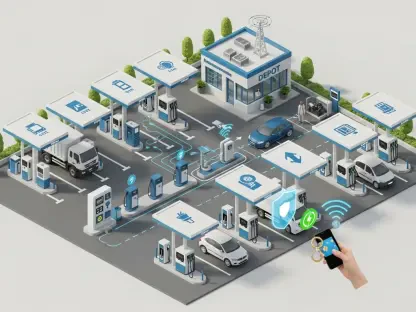Shetland, a remote archipelago in Scotland, is undergoing a remarkable transformation in its energy sector, driven by the urgent need to modernize outdated systems and embrace sustainable practices while meeting growing demands for reliable electricity. With a global push toward low-carbon technologies, the islands are at a pivotal moment, balancing operational challenges with ambitious environmental goals. Major developments are underway, particularly at key facilities like Sullom Voe Terminal (SVT), alongside broader grid enhancements across the region. These initiatives aim to integrate isolated power systems into a more connected and resilient network, ensuring stability for local communities and industries. From transitioning gas-fired stations to grid connections to building backup systems for outages, the scope of these upgrades reflects a comprehensive strategy. This transformation not only addresses immediate energy needs but also sets a foundation for a greener future, positioning Shetland as a model for remote regions adapting to modern energy demands.
Sullom Voe Terminal’s Shift to Grid Integration
At the heart of Shetland’s electrical overhaul is the significant transition happening at Sullom Voe Terminal, a critical industrial hub. Currently powered by a 100MW gas-fired station, the terminal is preparing to decommission this self-sufficient system in favor of connecting to the local grid. This shift, facilitated by the North Mainland Shetland Reinforcement Project, involves extensive cabling through the Central Mainland to link SVT with the broader network. Planning applications for new infrastructure, including a switching compound and equipment room modules, have been submitted to support this integration. Additionally, an application to the Scottish Environmental Protection Agency (SEPA) seeks to extend a derogation, allowing the existing power station to operate until 2027 if needed. This temporary measure ensures continuity during the transition, highlighting a pragmatic approach to managing complex infrastructural changes while minimizing disruptions to operations.
Beyond the immediate logistics of grid connection, the decommissioning of SVT’s gas-fired power station marks a broader commitment to reducing reliance on fossil fuels. While there are no current plans to dismantle the station post-connection, the focus remains on integrating cleaner energy sources into the terminal’s operations. This move aligns with regional and national goals to lower carbon emissions, reflecting a strategic pivot toward sustainability. The project also underscores the importance of collaboration between industrial stakeholders and environmental regulators to balance economic needs with ecological priorities. As SVT prepares for this monumental shift, the implications extend beyond the terminal itself, influencing energy policies and practices across Shetland. The successful execution of this transition could serve as a blueprint for other industrial facilities in remote areas, demonstrating how to modernize infrastructure while adhering to stringent environmental standards.
Enhancements at Lerwick Power Station and Beyond
Parallel to the changes at SVT, Lerwick Power Station is undergoing its own set of upgrades to bolster Shetland’s energy reliability. The station is slated to shift into standby mode once the islands connect to the national grid through a High Voltage Direct Current (HVDC) subsea cable, expected to be operational soon. To mitigate risks of outages on this cable, a battery storage system is being constructed in Lerwick, providing critical backup power while the station restarts from standby. Additionally, Scottish and Southern Electricity Networks (SSEN) plans to install new 6MW engines at the station to meet anticipated increases in demand over the coming years. These enhancements reflect a forward-thinking approach to energy security, ensuring that even as the region moves toward greater grid integration, there are robust mechanisms in place to handle unexpected disruptions or spikes in consumption.
Expanding beyond Lerwick, SSEN is also proposing additional infrastructure to strengthen the distribution network across Shetland. A new substation with a 33kV switch room is planned for the Firth area, near an existing facility, alongside another close to SVT. Spanning 87.9 square meters and standing 6.8 meters tall, the Firth substation is part of a larger scheme to increase network capacity and support future development. This project, expected to take around 12 months to complete, will create 15-20 jobs, offering an economic boost to the local community. The initiative aims to enhance the reliability and security of power supply while facilitating the adoption of low-carbon technologies. By addressing both current needs and future growth, these upgrades illustrate a multi-faceted strategy to modernize Shetland’s electrical framework, ensuring that the islands are well-equipped to handle evolving energy demands in a sustainable manner.
Building a Sustainable Energy Future
The overarching trend in Shetland’s electrical upgrades is a clear shift toward sustainability and resilience, evident in the diversity of projects reshaping the energy landscape. From SVT’s move away from gas-fired power to Lerwick’s standby transition and the addition of battery storage, each initiative contributes to a more interconnected and environmentally conscious system. The construction of new substations further amplifies this effort by expanding grid capacity and supporting innovative technologies that reduce carbon footprints. These developments collectively aim to meet growing electricity demands while aligning with global sustainability targets. The emphasis on backup systems and enhanced infrastructure also ensures that reliability remains a priority, safeguarding communities and industries against potential power interruptions in a region often challenged by harsh weather and isolation.
Reflecting on the progress made, the comprehensive overhaul of Shetland’s electrical infrastructure reveals a unified vision among stakeholders to prioritize long-term energy security. The strides taken in integrating major facilities like SVT into the grid, alongside upgrades at Lerwick and new substations, demonstrate a balanced approach to operational and environmental challenges. Looking ahead, the focus should shift to monitoring the effectiveness of these systems once fully operational, ensuring they deliver on promises of reliability and sustainability. Continued investment in low-carbon solutions and community engagement will be crucial to sustain momentum. Additionally, leveraging the job creation and economic benefits from projects like the Firth substation can foster local support for future initiatives. As Shetland adapts to an evolving energy landscape, these efforts lay a strong foundation for resilience and innovation, offering valuable lessons for other remote regions navigating similar transitions.









